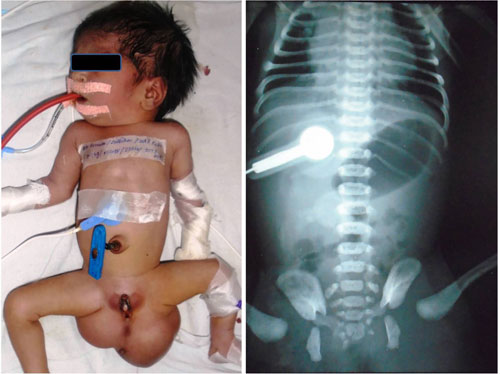|
|
|
Indian Pediatr 2016;53: 746-747 |
 |
VACTERL Association with Sacrococcygeal
Teratoma
|
|
*Rahul Gupta and Vinita Chaturvedi
Department of Paediatric Surgery, SMS Medical College,
Jaipur, Rajasthan, India.
Email:
[email protected]
|
|
VACTERL association refers to the non-random co-occurrence (1 in 10,000
to 1 in 40,000 live-born infants) of vertebral anomalies (V), anal
atresia (A), congenital heart defects (C), tracheoesophageal fistula
(TE), renal anomalies (R) and limb defects (L) [1,2]. It is typically
defined by the presence of at least three of them without clear evidence
for an alternate, overlapping diagnosis [1-3]. The occurrence of VACTERL
association with sacrococcygeal teratoma (SCT) is extremely rare.
A 2-day-old female neonate presented with a large
sacrococcygeal lump with absent normal anal opening (Fig. 1).
The patient was in respiratory distress with nasal flaring. Examination
revealed vestibular fistula, fine crepitations with presence of cardiac
murmur. Failure to negotiate a red rubber catheter down the esophagus
suggested the presence of esophageal atresia. Radio-logical evaluation
confirmed the presence of esophageal atresia with tracheoesophageal
fistula (TEF), increased cardio-thoracic ratio, Altmanís type I SCT (Fig.
1), and left multicystic kidney. Thoracotomy with staged repair of
Vogt type3b was performed. Postoperatively patient developed sclerema
and died. Echocardiography to confirm the presence of cardiac anomalies,
and tumor markers for teratoma were not possible due to resource
constraints. In addition to SCT, we made a diagnosis of VACTERL
association owing to presence of three anomalies in our patient.
 |
|
Fig. 1 (a) Neonate with sacrococcygeal
teratoma type 1,small perineum and vestibular fistula, with red
rubber catheter not going beyond 10 cms into the esophagus; (b)
radiograph showing dilated stomach shadow, soft tissue shadow in
the sacrococcygeal region, normal vertebrae and increased
cardiothoracic ratio.
|
VACTERL association specifically refers to the
structural abnormalities derivative of the embryonic mesoderm
(disruption in the proliferation, migration and differentiation of
mesoderm) [1]. Epiblasts cells migrating from primitive node and
proximal part of primitive streak lead to the formation of notochord,
paraxial and intermediate plate mesoderm [4]. Failure of some of these
epiblasts cells to migrate will lead to remnants at primitive streak
which may persist in sacrococcygeal region as a teratoma[4].
We propose that VACTERL association and SCT may be
more than a chance association in our patient. Clinicians should have
high index of suspicion for VACTERL association in a neonate presenting
with sacrococcygeal teratoma and anorectal malformation.
References
1. Solomon BD. VACTERL/VATER Association. Orphanet J
Rare Dis. 2011;6:56.
2. Khoury MJ, Cordero JF, Greenberg F, James LM,
Erickson JD. A population study of the VACTERL association: Evidence for
its etiologic heterogeneity. Pediatrics. 1983;71:815-20.
3. Quan L, Smith DW. The VATER association. Vertebral
defects, Anal atresia, T-E fistula with esophageal atresia, Radial and
Renal dysplasia: a spectrum of associated defects. J Pediatr.
1973;82:104-7.
4. Sadler TW. Langmanís Medical Embryology,10th ed. Philadelphia:
Lippincott Williams & Wilkins; 2012.
|
|
|
 |
|

